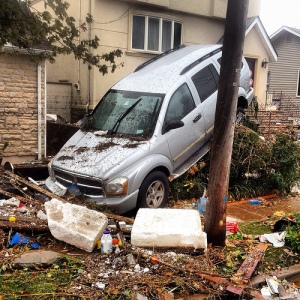Hurricane Sandy demonstrated its power as it hit the nation’s Northeast Coast Monday and Tuesday, affecting millions in the country’s most densely populated region. The storm changed the coastline of New Jersey and New York, knocked down trees, cut off communication and transportation and left more than 8 million people without electricity Tuesday.
Among them is Jiamin Wang, 23, from Beijing, who is studying Human Resources Management at Pace University in New York City.
“My roommates and I woke up this morning and found there was no electricity and gas in our house,” Wang said.“But we knew it would happen sooner or later, so we were not that surprise.”
The storm made landfall near Atlantic City, N.J., with maximum sustained winds of about 80 miles per hour, and has killed at least 98 people, causing havoc and leaving a moonscape of disarray and debris in New York City and several counties in New Jersey.

A Dodge Durango feels the impact of Hurricane Sandy on Armstrong Avenue in Great Kills, State Island, N.Y. Waters rising 15 feet must of carried this half way up the block. Photo searched on Flickr under Creative Commons.
“There was chaos, and the road around my apartment became rivers when the hurricane arrived,” Wang said. “I’ve never experienced hurricanes in my life, and I called my family and friends immediately.”
The power and gas outage forced Wang to stay at her friend’s house temporarily. With no Internet access, all she could use to reach out the world was her friend’s mobile phone, and the signal was extremely weak.
The tropical storm formed south of Jamaica a week and a half ago and began to cruise north since then, dutifully following the predicted track. Washington, D.C. was also in Sandy’s path. The teeming federal city turned into a ghost town when the federal and state governments and schools closed.
“It was terrible and damaging,” said Peiyue Huang, a public communication graduate at American University (AU).
Huang is from Guangzhong, a city in southeast China where storms and typhoons frequently occur in the summer.
“We don’t have hurricanes in Guangzhou, but to me they’re the same,” Huang said, “It made me feel like I was at home.”
But there was one thing that Huang felt different: the school alert.
“I appreciated [the] AU alert,” she said. “It was very comprehensive and updated, from the hours of library, shuttles, to cafes. I don’t remember schools in Guangzhou … as thoughtful as those in the States.”
In fact, the hurricane here made some Chinese students start to compare the different handling methods between the two countries.

Cars submerged in floodwaters around a residential block after heavy rains in Beijing on July 21, 2012. Photo by Ching Chin/EPA
Last July in Beijing, urban areas were hit with an average of nearly nine inches of rain over 16 hours — the heaviest the Chinese capital has seen in six decades, according to the Xinhua news agency. Seventy-seven people were killed by drowning, electrocution, lightning and collapsed structures. The storm stranded cars and buses and turned the city into lakes of waist-deep water.
“The rain was pouring down, and everybody was running and trying to find a place to hide or get a cab,” said Dongyu Li, a student from Beijing. “But it was extremely hard.”
Li went to a concert with her boyfriend on that day despite the storm.
Li said she didn’t want to waste her ticket. “I didn’t get any alerts saying that the rain would be so devastating,” she said. “All I knew from the weather forecast was there would be a heavy rain today.”
As a graduate student in Washington, Li was “fortunate enough” to experience another superstorm Sandy on this foreign land. In contrast to the lack of information in Beijing, she was, instead, overwhelmed this time by all sorts of news about Hurricane Sandy.
“I searched the Internet to track the news of the hurricane,” Li said, “I found that both the New York Times and the Washington Post had updates on the current situations with their local angels, which were very helpful and informative.”
Wang agreed that the media played an important role during the hurricane here in the States.
“I used Sina Weibo (a Twitter equivalent in China) to find what was going on when the storm hit Beijing,” Wang said. “But here I felt like there were more channels, whether it was official weather report, or news alerts.”
